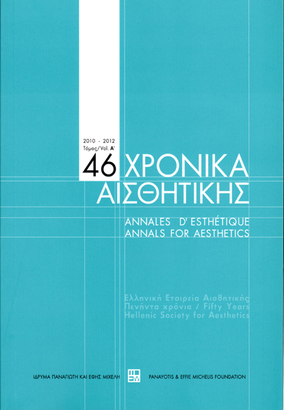"Αισθητική" και φιλοσοφία της τέχνης στον Αριστοτέλη
Part of : Χρονικά αισθητικής : ετήσιον δελτίον της Ελληνικής Εταιρείας Αισθητικής ; Vol.46, No.Α, 2010, pages 251-274
Issue:
Pages:
251-274
Parallel Title:
“Aesthetics” and philosophy of art in Aristoteles
Section Title:
Αισθητική - Φιλοσοφία της Τέχνης - Ιστορία της Τέχνης Aesthetics/Philosophy of Art - History of Art
Author:
Abstract:
I. The knowledge of the nomenclature and range of notions of the Ancient Greeks’ artistic language forms as much of a prerequisite as of a necessary stipulation for comprehending this ancient people’s philosophy of art as well as aesthetic conceptions. Knowing Plato’s ideas about art is also just as much of a requirement to this effect.The Greeks, as it is widely granted, did not discern a particular philosophical branch pertaining to aesthetics, such as it has been known in post-Renaissance times and, most importantly, after Winckelmann. All Greek philosophers and thinkers talk about the concept of beautiful (“ka/os”) to which they ascribe a moral aspect, as beautiful is at the same time virtuous. In addition, the theory of art is relieved of the aestheticism which is inherent to the notion of artistry in modern times. Art, in ancient times, bears more upon the human community and is understood as a reflection of civilian morals. II. Plato inherited his predecessors’ (Antiphon, Demokritus) conception that imitation (Nachahmung) is related to learning (Antiphon A3 and Demokritus B39). Imitation has a positive meaning according to these two thinkers. Plato, however, consistent with or rather a captive of the theory of Ideas - the culmination of his theory, of knowledge - considered imitation as a pattern of mimicry or simulation, i.e. an act of copying or simulating all things sensible which are, of course, mere reflections/depictions of Ideas; consequently, poets (as well as all artistic creators) imitate just portrayals of things, not the actual things themselves (the Ideas); the Ideas are the beings in their ultimate essence, the very truth for everything in existence. Plato therefore arrived at the “reasonable” conclusion that the poet stands on the “third step from the truth” (Politela 597e6, 599d2, 602c1. Cf 600e6: (the poets) do not border upon the truth, 598b: (the poets are) far off from the truth etc.). Plato, by postulating this thesis, brought on to the philosophical foreground the old dispute between poetry and philosophy (Politela 607d).III. Aristotle, as opposed to Plato, followed the reverse course with regard to the meaning of imitation. He relates again, that is, imitation to learning and lends the dimension of representation and creation to imitation; nevertheless, like Plato, he considers arts in their entirety as imitations; however it is clear that imitation now acquires a positive meaning and is related to human nature as a condition of learning (Poet. 1, 1447, A13-16, cf.4,1448 B 5-9, Rhet.A11,1371, B4-10). Imitation now means a pure artistic representation of the very essence of beings and not simply simulating or copying them. Poets and artists alike endeavour to express/formulate the “kind” or format of things through “material” means (words, colours, musical tones, marble, copper etc.).IV. The meaning of beautiful and beauty/comeliness has a mathematical derivation for the ancient Greeks, according to how Aristotle understands it (Metaph. M3,1078b 1-2). The attributes of beautiful are, after all, rendered in mathematical concepts: order, symmetry, designated/determinate, proportion/ration etc. Nature, with regard to the concept that the Greeks had of it, contains the perfect expression of beautiful. The meaning of beautiful reflects human effort to balance passions and prevail over instincts and impulses, hence to become (cf. beautiful and virtuous).
Subject:
Subject (LC):
Keywords:
Αριστοτέλης




